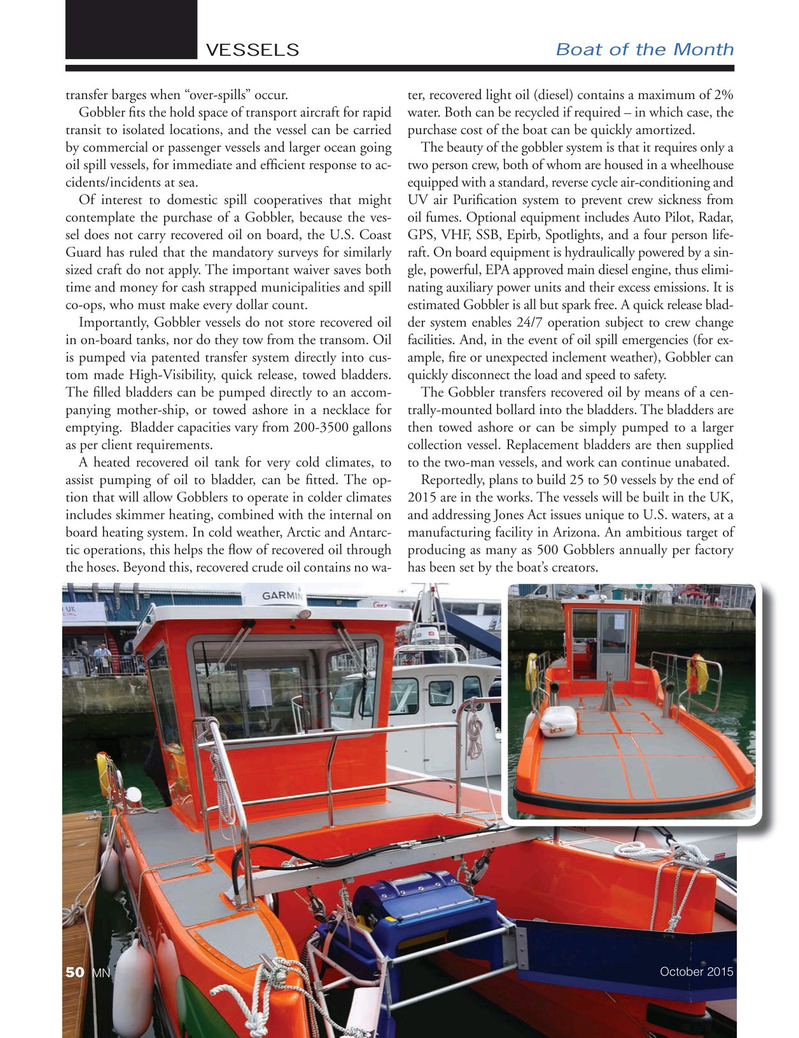
Page 50: of Marine News Magazine (October 2015)
Salvage & Spill Response
Read this page in Pdf, Flash or Html5 edition of October 2015 Marine News Magazine
VESSELS Boat of the Month transfer barges when “over-spills” occur. ter, recovered light oil (diesel) contains a maximum of 2%
Gobbler ? ts the hold space of transport aircraft for rapid water. Both can be recycled if required – in which case, the transit to isolated locations, and the vessel can be carried purchase cost of the boat can be quickly amortized. by commercial or passenger vessels and larger ocean going The beauty of the gobbler system is that it requires only a oil spill vessels, for immediate and ef? cient response to ac- two person crew, both of whom are housed in a wheelhouse cidents/incidents at sea. equipped with a standard, reverse cycle air-conditioning and
Of interest to domestic spill cooperatives that might UV air Puri? cation system to prevent crew sickness from contemplate the purchase of a Gobbler, because the ves- oil fumes. Optional equipment includes Auto Pilot, Radar, sel does not carry recovered oil on board, the U.S. Coast GPS, VHF, SSB, Epirb, Spotlights, and a four person life-
Guard has ruled that the mandatory surveys for similarly raft. On board equipment is hydraulically powered by a sin- sized craft do not apply. The important waiver saves both gle, powerful, EPA approved main diesel engine, thus elimi- time and money for cash strapped municipalities and spill nating auxiliary power units and their excess emissions. It is co-ops, who must make every dollar count. estimated Gobbler is all but spark free. A quick release blad-
Importantly, Gobbler vessels do not store recovered oil der system enables 24/7 operation subject to crew change in on-board tanks, nor do they tow from the transom. Oil facilities. And, in the event of oil spill emergencies (for ex- is pumped via patented transfer system directly into cus- ample, ? re or unexpected inclement weather), Gobbler can tom made High-Visibility, quick release, towed bladders. quickly disconnect the load and speed to safety.
The ? lled bladders can be pumped directly to an accom- The Gobbler transfers recovered oil by means of a cen- panying mother-ship, or towed ashore in a necklace for trally-mounted bollard into the bladders. The bladders are emptying. Bladder capacities vary from 200-3500 gallons then towed ashore or can be simply pumped to a larger as per client requirements. collection vessel. Replacement bladders are then supplied
A heated recovered oil tank for very cold climates, to to the two-man vessels, and work can continue unabated.
assist pumping of oil to bladder, can be ? tted. The op- Reportedly, plans to build 25 to 50 vessels by the end of tion that will allow Gobblers to operate in colder climates 2015 are in the works. The vessels will be built in the UK, includes skimmer heating, combined with the internal on and addressing Jones Act issues unique to U.S. waters, at a board heating system. In cold weather, Arctic and Antarc- manufacturing facility in Arizona. An ambitious target of tic operations, this helps the ? ow of recovered oil through producing as many as 500 Gobblers annually per factory the hoses. Beyond this, recovered crude oil contains no wa- has been set by the boat’s creators.
October 2015
MN 50
MN Oct15 Layout 50-58.indd 50 9/21/2015 11:39:31 AM

 49
49

 51
51
